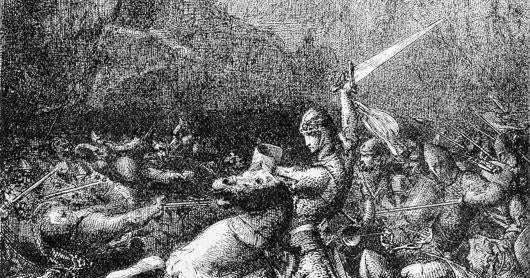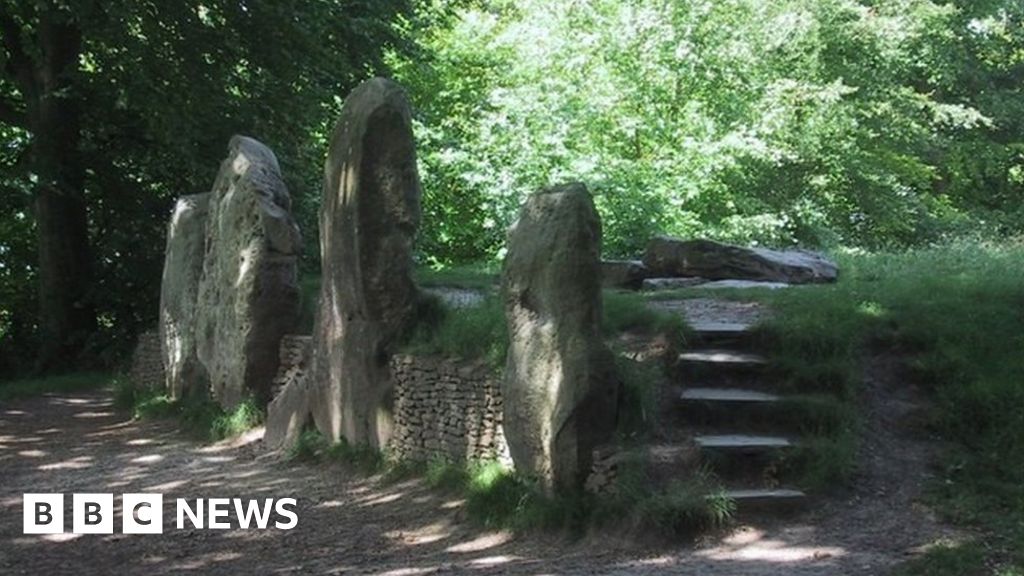
Next stop - Wayland's Smithy, Oxfordshire
England's Wayland's Smithy is a place of great mythic meaning, a tangible link to times of gods, elves, evil kings, and Arthurian legends. The atmospheric, eerie, early-Neolithic, chambered stone long barrow can be found close to the village of Ashbury in England’s leafy Oxfordshire.
Wayland’s Smithy is approximately 185 feet (56.4 metres) long by 43 feet (13 metres) wide, and was built in two distinct phases – well before the mythic Wayland (much more of whom shortly) apparently resided there. The ruin resonates with three periods of time: pre-recorded history, Anglo-Saxon England, and the Middle Ages.
The first Wayland’s Smithy was a mortuary structure of stone and wood. A narrow wooden box lay on a pavement of sarsen stone slabs, in which folk were buried. The remains of 14 people – 11 men, two women and a child – were found when it was excavated in 1963. The first burials were probably placed there in 3590–3555 BC, and the last in 3580–3550 BC. Used for no more than 15 years, less than a single generation, or maybe an even shorter period, perhaps just a year, some have speculated.
A second, larger barrow (now known as Wayland’s Smithy II), with a monumental stone facing, was built over the top between about 3460 and 3400 BC, absorbing the older mound altogether. This barrow is thought to have remained in use for burials for less than 100 years. The second Wayland’s Smithy II was a very late construction compared to other long barrows, built in the style of older monuments such as the West Kennet Long Barrow two centuries earlier. Did the builders feel the need to create a sense of history, claiming an ancestral connection to the area?
Legend of ‘the invisible smith’
In the Dark Ages, Wayland’s Smithy (once known as Wayland Smith’s cave), was first mentioned by either name in an early medieval land deed (908AD) from Compton Beauchamp, documented in a charter from King Eadred in 955 AD.
An old tale says if a traveller’s horse lost a shoe on the road, he should bring the horse to the barrow and leave it overnight with a coin. When he returned the next day, the horse would be shod and the money absent. The legend of ‘the invisible smith’ was well-known by the 18th century, and familiar to both Walter Scott (1821’s Kenilworth) and Rudyard Kipling (Puck of Pook's Hill, 1906) both using the legend and place in their novels.
Reviving the tradition, coins have been left at at the site since at least the 1960s, visitors lodging the coins into cracks in the site's stones. Coins assiduously removed by the wardens of the Smithy are donated to local charities. Folklorist Ceri Houlbrook noted on the leaving of coins it,"contributes to the ritual narrative of a site."
However, the association with the mysterious Wayland the Smith is far, far older...
Norse elf, Völundr, a smith of brilliant, supernatural skill

Weland, as the Anglo-Saxons knew him, was in reality the Norse elf, Völundr, a smith of brilliant, supernatural skill, whose reputation for creating both beautiful weapons and jewellery was known throughout Scandinavia. Greedy King Niduth of Sweden thus desired Völundr as his personal smith, kidnapping and ham-stringing him to prevent escape, forcing the elf into servitude.
Völundr went along with this as a pretence, but then hoodwinked the king’s two young sons into his forge, chopped their little noggins off to make gold goblets from their skulls and glittering jewels from their eyes and gnashers. Akin to Shakespeare’s Titus Andronicus and the cooked Gothic brats*, he presented these wonderful gift baubles to the avaricious king, his queen, and their daughter, who were all predictably very happy - the fools.
Although happy to gulp wine from his new goblets, Niduth sent servants out to track down his now-missing lads. Meanwhile, the king’s daughter Princess Beahilda asked crafty Völundr to fix a beautiful-but-too-large ring her loving father had recently gifted her. Recognizing it as the one he had made for his wife the Swan-Princess (presumably slain by Niduth’s minions), Völundr became even more incensed at his cruel treatment by the king.

Völundr, in his rage, drugged and raped the princess, flying from Niduth’s castle on magic wings, taunting the king that his only male heir now was now growing inside Beahilda’s womb – as indeed it was.
After a long, weary flight, Völundr descended to the Berkshire downs, making an new, enchanted abode inside the ancient tomb. From then onwards, the elven smith made many great things there, such as the sword Excalibur, that his chum Merlin asked him to fashion.
The industrious elf also made Durandal - the indestructible sword of Roland (737-778 AD), legendary paladin of Emperor Charlemagne (748-814 AD). Tradition has it that Roland cut a huge gash in the rocks with one blow, forming Roland's Breach in the Pyrenees. Local folklore also claims Durendal still exists, embedded in a cliff wall in Rocamadour (Lot). But the local tourist office says it is a mere replica. And, in addition, Weyland also created the chain mail shirt worn by the heroic Beowulf.
*STOP PRESS* DURANDAL STOLEN (04/06/24)


Völundr – or Wayland as he became known as to the English (named by the Saxons who settled in the area some four thousand years after Wayland's Smithy was built) - lives there still. And, some say, can be still be heard, busy knocking stuff up at his forge.
But what happened to Princess Beahilda and her child by Völundr?
According to the 13th century Þiðrekssaga, she gave birth to a son called Viðga. Wayland settled a peace agreement with Otvin (supposedly the older son of Niduth, which kind of negates the point of the earlier telling) and he then married Beahhilda/Böðvildr.
The 10th century Anglo-Saxon poem Deor suggests not- such-a-happy ending:
so painful to her heart as her own problem
which she had readily perceived
that she was pregnant; nor could she ever
foresee without fear how things would turn out.
That went by, so can this
In yet another version, their son is the hero Witege, who wielded the sword Mimung, forged by his dad. He is mentioned in the fragmentary Anglo-Saxon poem Waldere, together with the blade:
a better sword
except the one that I have also in
its stone-encrusted scabbard laid aside.
I know that Theodoric thought to Widia's self
to send it and much treasure too,
jewels with the blade, many more besides,
gold-geared; he received reward
when Nithhad's kinsman, Widia, Welund's son,
delivered him from durance;
through press of monsters hastened forth.
Related fare: The Ring of the Nibelungs movie (not available in certain countries)
Radiohead recorded a music video at the Smithy in 1993 for their Pop Is Dead single, although you can’t really make out much, to be frank.


Great White Horse of Uffington awakens every hundred years
In the distance from the Smithy, Uffington Castle looms; when our distant ancestors built the hillfort, the people laid to rest in the barrow had already been dead for two thousand, eight-hundred years.
Some used to say the great White Horse on the hillside at Uffington is the magnificent Grannie, shod by Wayland for Norse hero, Sigurd, now frozen in chalk. That is until every hundred years, when the White Horse awakes, and thunders across the sky to Wayland’s Smithy, where the smith has to shoe the horse once more. This, apparently, last happened in 1920 at a local tavern.
One evening at the White Horse Inn, at Woolstone in the vale below the Uffington, an unknown man in archaic clothes entered and ordered a pint of the local brew. The sound of a hunting horn then resounded loudly; when it was repeated, the mysterious stranger leapt to his feet and limped hurriedly outside.

The pub’s customers looked up to the hillside - the White Horse was gone, but the next morning it was back, with hooves that appeared to glisten in the sunlight.

Wayland's Smithy masked night-time shindigs
Disturbingly, in recent years, Wayland's Smithy has been used for masked night-time shindigs by the neo-Nazi Woden's Folk, The Telegraph newspaper reporting that swastikas had been carved into trees at the site.
Something of Hitler’s obsession with the occult and Nordic gods?
Modern Pagans, including Druids and Heathens have also frequented Wayland's Smithy for ritual purposes, attempting to communicate with Spirits of the Earth, long-deceased ancestors and the also Earth Goddess (Danu?) there.
Stephen Arnell’s novel THE GREAT ONE is available on Amazon Kindle now:
*













:max_bytes(150000):strip_icc():focal(749x0:751x2)/Queens-Menagerie-at-Tower-of-London52-2610a61458a048b8a5d0f334ccb39e7a.jpg)







